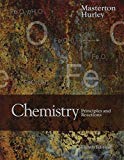
Concept explainers
(a)
Interpretation:
The formula of a compound formed with hydrogen and sulfur needs to be determined.
Concept introduction:
All the elements in the periodic table can be classified as metals, non-metals and metalloids. Metals are electropositive elements which mainly form basic oxides and non-metals are electronegative elements, they mainly form acidic oxides. Non-metals are placed at the right side of the periodic table and their oxides react with water to form acidic solutions. Hydrogen is a unique element which can react with metal as well as non-metals. It forms hydride with metals and different acidic compounds with non-metals.
(b)
Interpretation:
The formula of a compound formed with hydrogen and nitrogen needs to be determined. The compound so formed must be liquid at 1 atm and
Concept introduction:
All the elements in the periodic table can be classified as metals, non-metals and metalloids. Metals are electropositive elements which mainly form basic oxides and non-metals are electronegative elements, they mainly form acidic oxides. Non-metals are placed at the right side of the periodic table and their oxides react with water to form acidic solutions. Hydrogen is a unique element which can react with metal as well as non-metals. It forms hydride with metals and different acidic compounds with non-metals.
(c)
Interpretation:
The formula of a compound formed with hydrogen and phosphorus needs to be determined. The compound so formed must be a poisonous gas at 1 atm and
Concept introduction:
All the elements in the periodic table can be classified as metals, non-metals and metalloids. Metals are electropositive elements which mainly form basic oxides and non-metals are electronegative elements, they mainly form acidic oxides. Non-metals are placed at the right side of the periodic table and their oxides react with water to form acidic solutions. Hydrogen is a unique element which can react with metal as well as non-metals. It forms hydride with metals and different acidic compounds with non-metals.
Want to see the full answer?
Check out a sample textbook solution
Chapter 21 Solutions
Bundle: Chemistry: Principles and Reactions, 8th, Loose-Leaf + OWLv2, 1 term (6 months) Printed Access Card
- Indicate the products of the reaction of Cycloheptanone with pyrrolidine (cat. H+). Draw the structures of the compounds.arrow_forwardIndicate the products of the reaction of 2-(3-aminopropyl)cyclohexan-1-one with H2SO4. Draw the structures of the compounds.arrow_forwardIndicate the products of the reaction of 2-cyclopentyl-2-methyl-1,3-dioxolane with H3O+. Draw the structures of the compounds.arrow_forward
- Question 4 For the molecule shown below, (7 marks): A) Sketch the Newman projection for the view looking along the bond from the perspective of the arrow. B) Then, draw the Newman projection for each 60° rotation along the bond until it returns to the starting point. C) Clearly indicate which Newman projection is the one we see in the structure shown below, and clearly indicate which Newman projection is the highest in energy and which is the lowest in energy. H H Me 'H Me Mearrow_forwardDraw the major product of this reaction. Ignore inorganic byproducts and the amine side product. 'N' 1. NaOH, heat 2. Neutralizing work-up Select to Drawarrow_forwardSubmit Problem 3 of 10 Draw the major product of this reaction. Ignore inorganic byproducts and the amine side product. O 'N' NH 1. NaOH, heat 2. Neutralizing work-up Select to Drawarrow_forward
- b) Certain cyclic compounds are known to be conformationally similar to carbohydrates, although they are not themselves carbohydrates. One example is Compound C shown below, which could be imagined as adopting four possible conformations. In reality, however, only one of these is particularly stable. Circle the conformation you expect to be the most stable, and provide an explanation to justify your choice. For your explanation to be both convincing and correct, it must contain not only words, but also "cartoon" orbital drawings contrasting the four structures. Compound C Possible conformations (circle one): Детarrow_forwardLab Data The distance entered is out of the expected range. Check your calculations and conversion factors. Verify your distance. Will the gas cloud be closer to the cotton ball with HCI or NH3? Did you report your data to the correct number of significant figures? - X Experimental Set-up HCI-NH3 NH3-HCI Longer Tube Time elapsed (min) 5 (exact) 5 (exact) Distance between cotton balls (cm) 24.30 24.40 Distance to cloud (cm) 9.70 14.16 Distance traveled by HCI (cm) 9.70 9.80 Distance traveled by NH3 (cm) 14.60 14.50 Diffusion rate of HCI (cm/hr) 116 118 Diffusion rate of NH3 (cm/hr) 175.2 175.2 How to measure distance and calculate ratearrow_forwardFor the titration of a divalent metal ion (M2+) with EDTA, the stoichiometry of the reaction is typically: 1:1 (one mole of EDTA per mole of metal ion) 2:1 (two moles of EDTA per mole of metal ion) 1:2 (one mole of EDTA per two moles of metal ion) None of the abovearrow_forward
- Please help me solve this reaction.arrow_forwardIndicate the products obtained by mixing 2,2-dimethylpropanal with acetaldehyde and sodium ethoxide in ethanol.arrow_forwardSynthesize 2-Ethyl-3-methyloxirane from dimethyl(propyl)sulfonium iodide using the necessary organic or inorganic reagents. Draw the structures of the compounds.arrow_forward
 Chemistry: Principles and ReactionsChemistryISBN:9781305079373Author:William L. Masterton, Cecile N. HurleyPublisher:Cengage Learning
Chemistry: Principles and ReactionsChemistryISBN:9781305079373Author:William L. Masterton, Cecile N. HurleyPublisher:Cengage Learning
